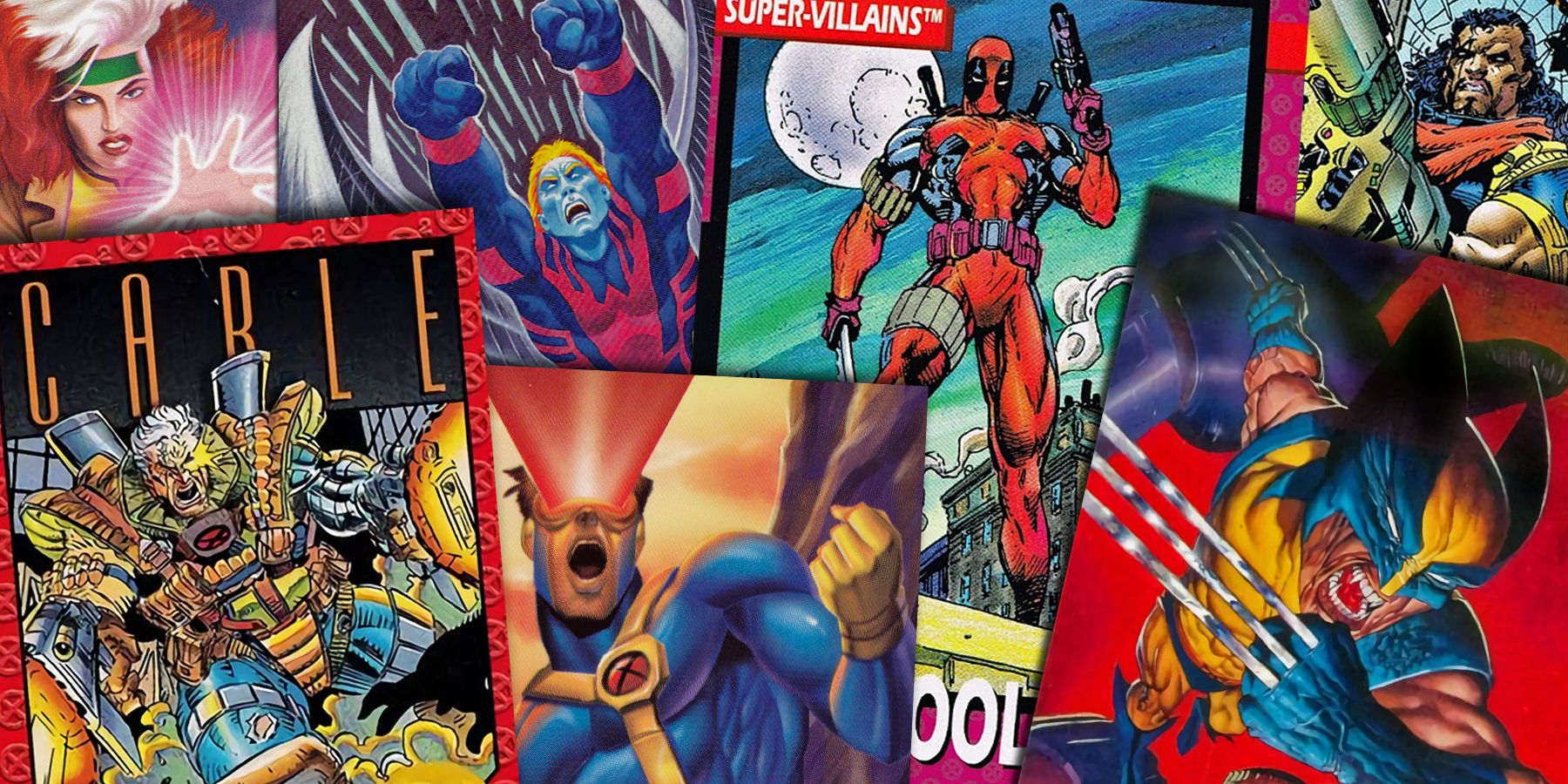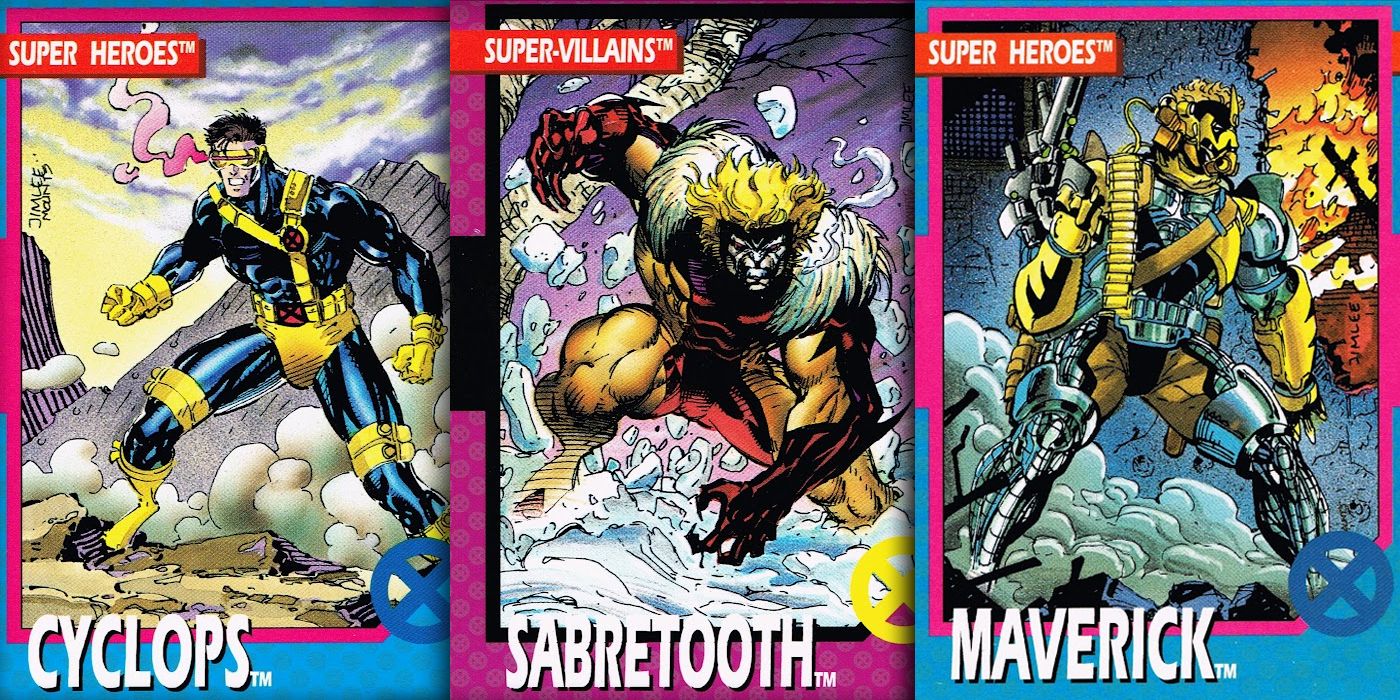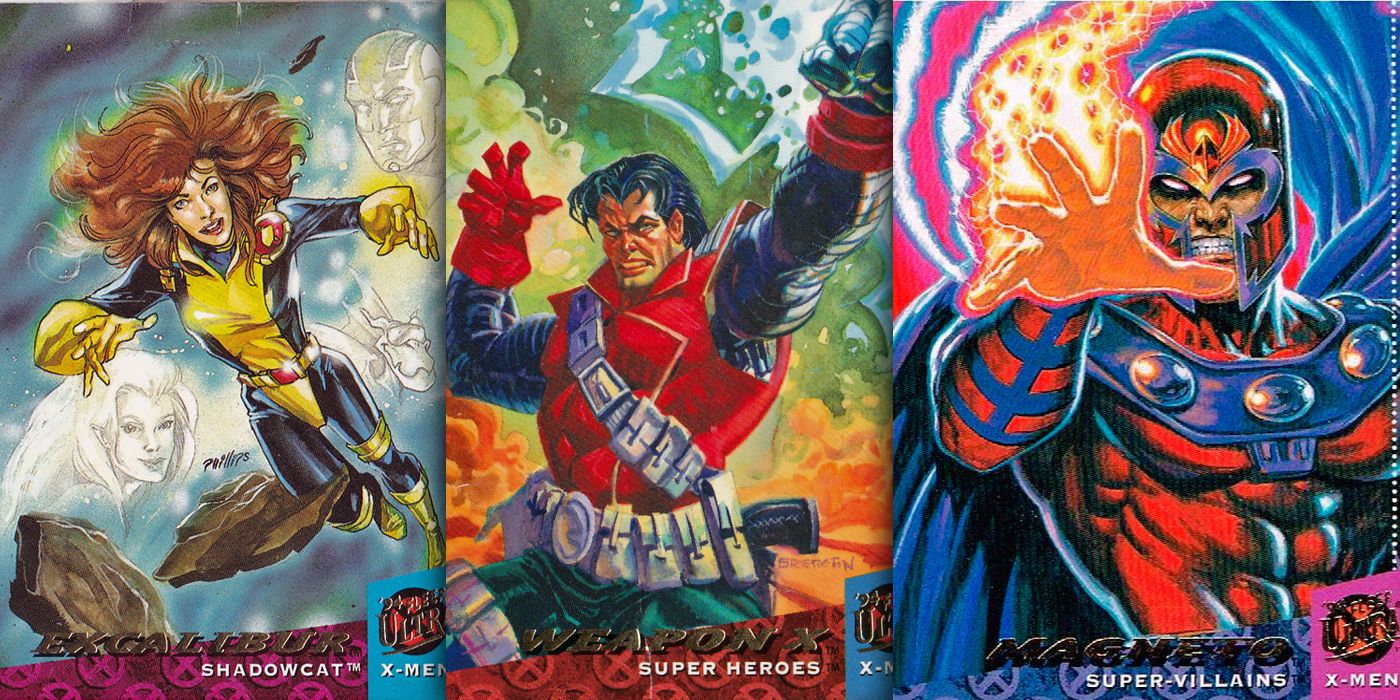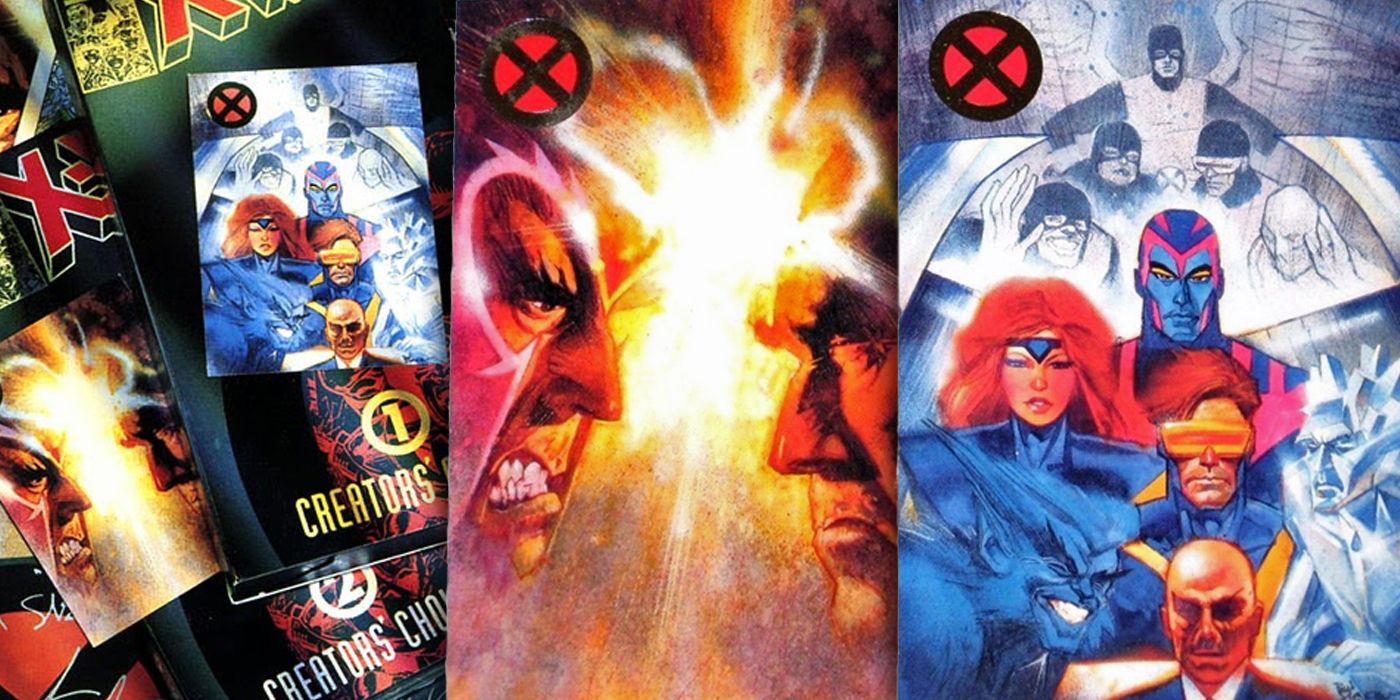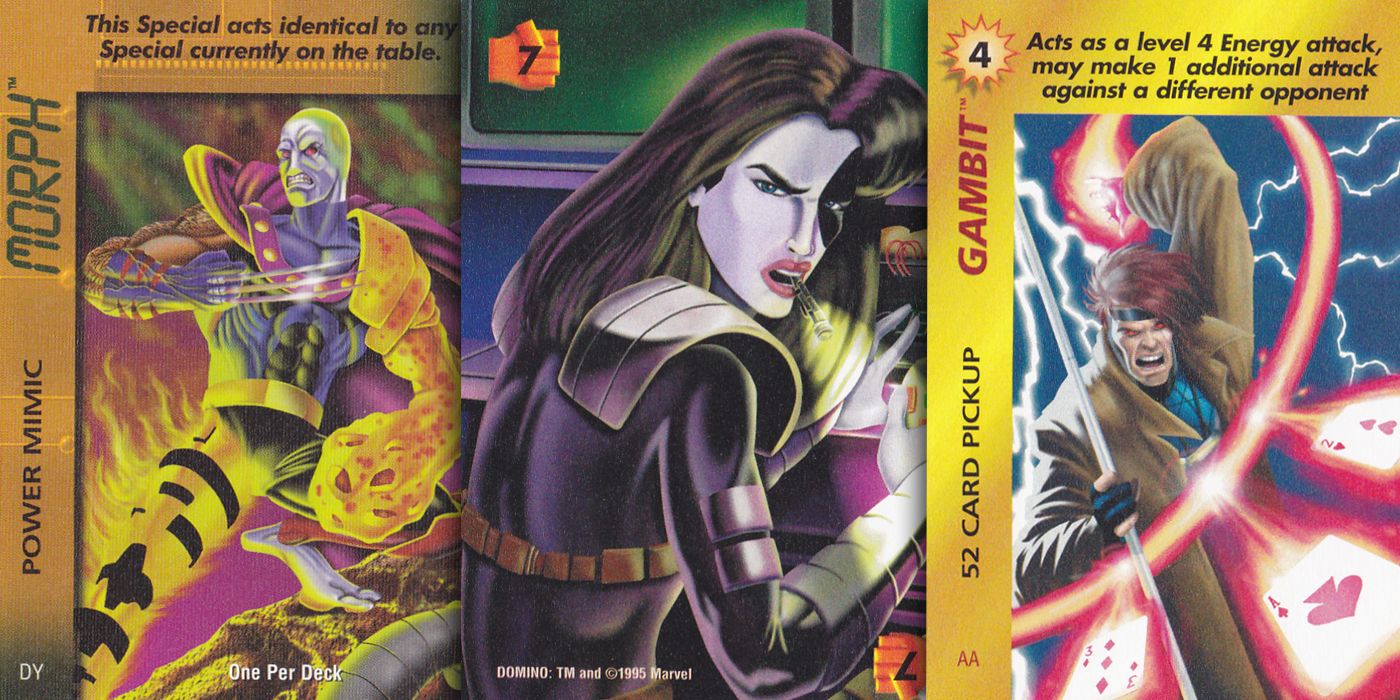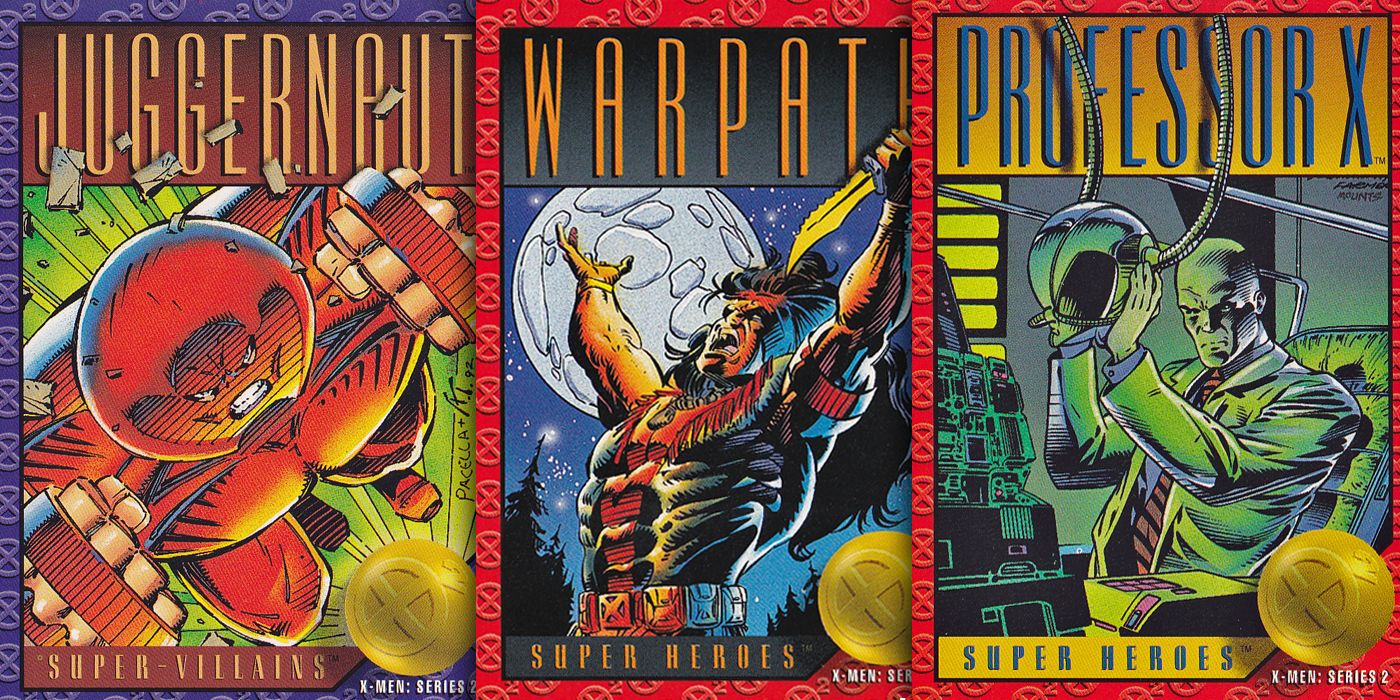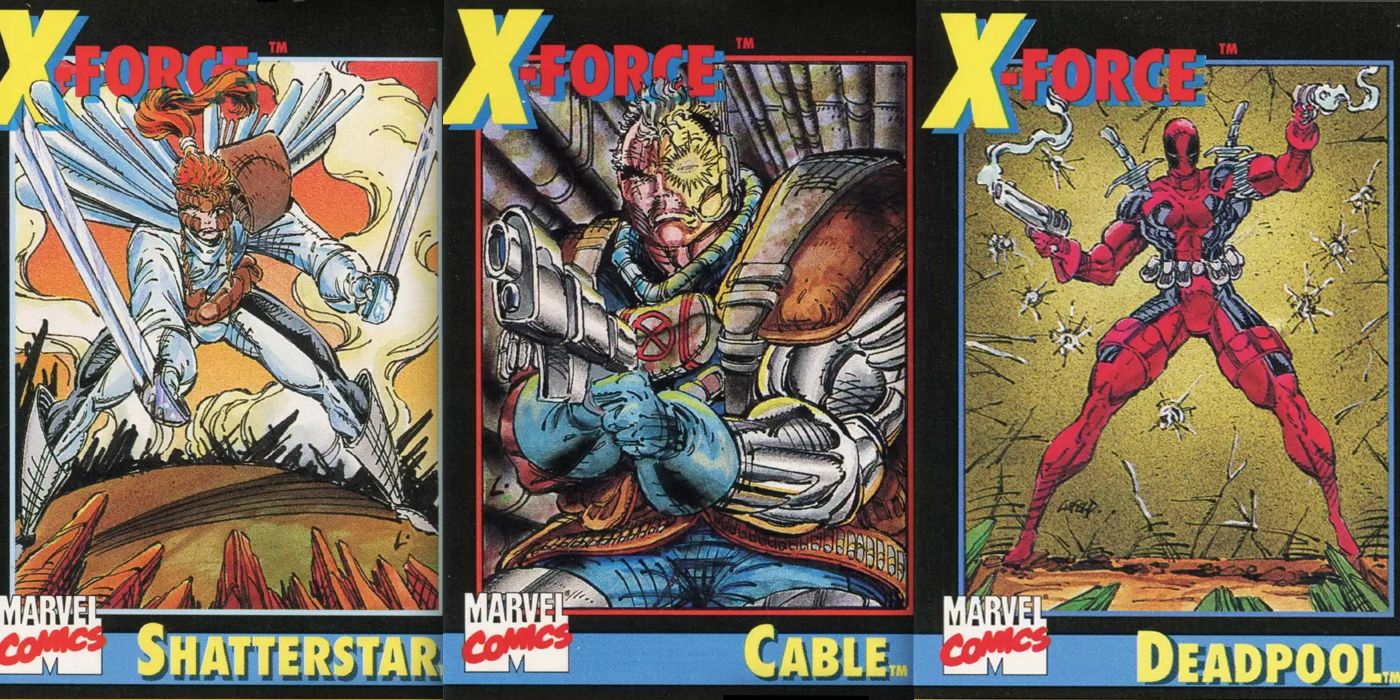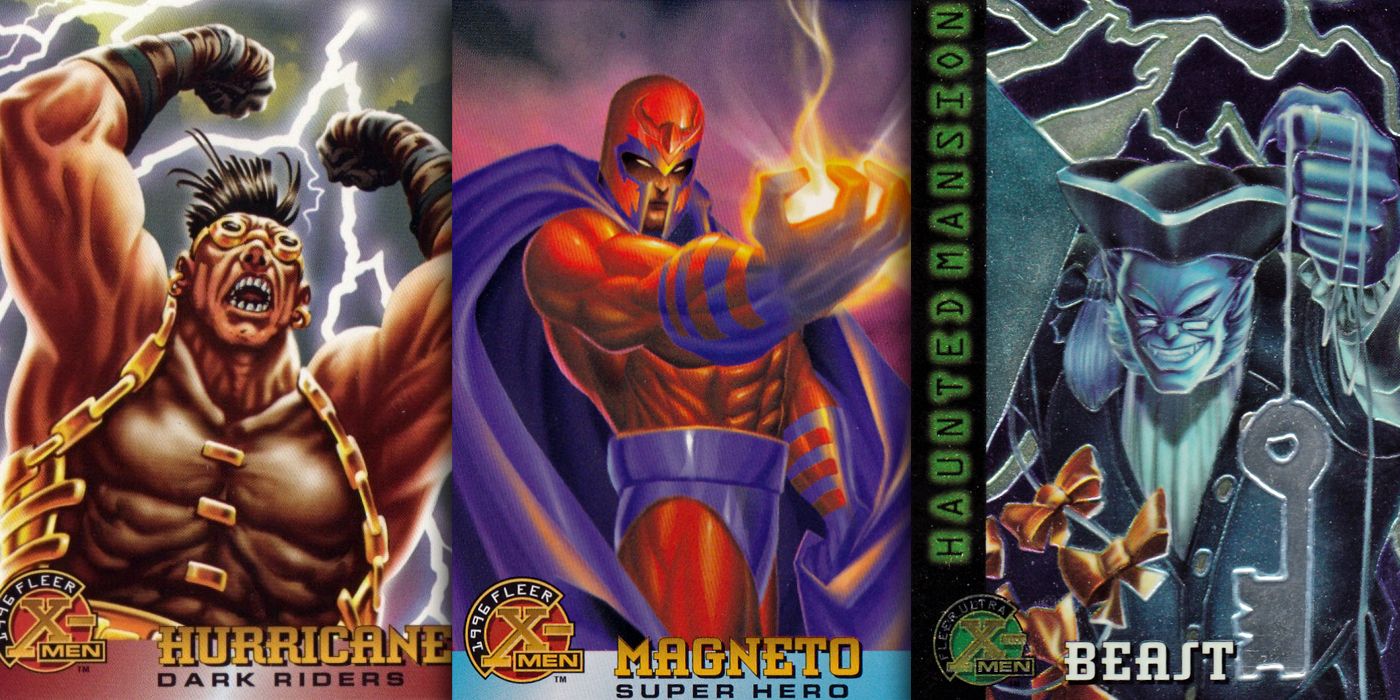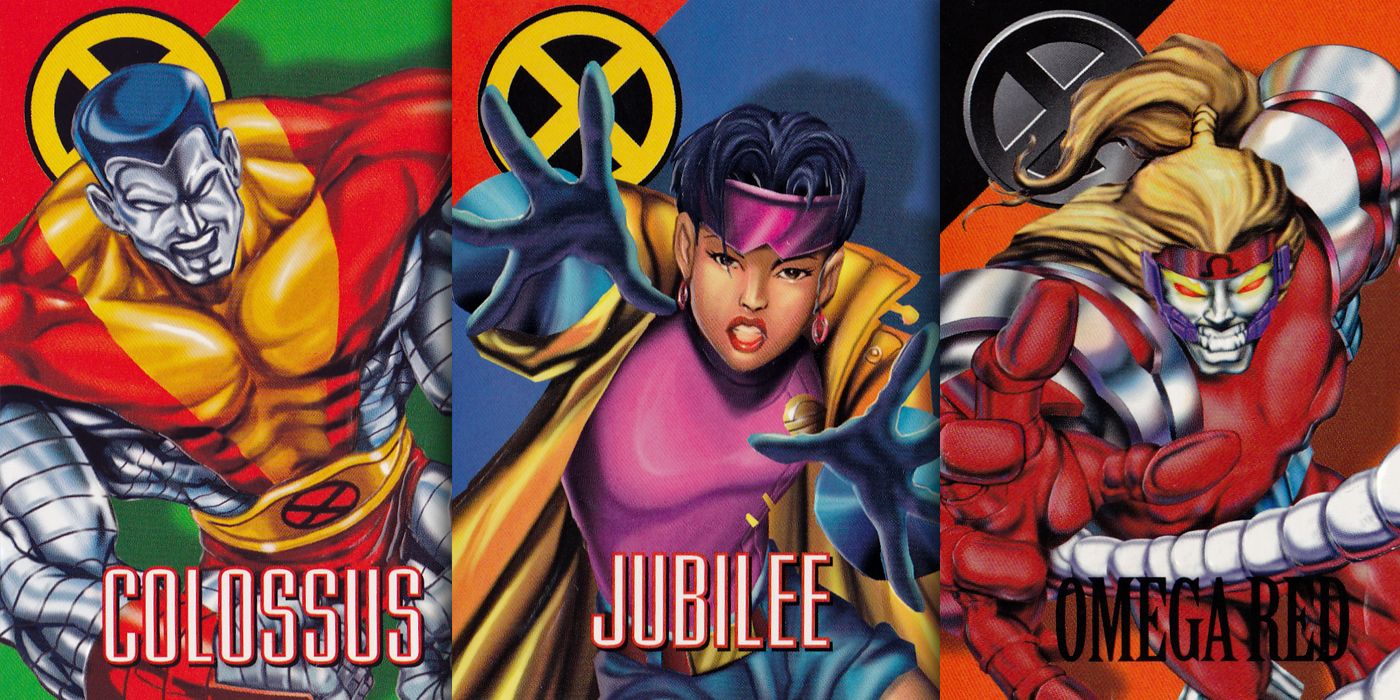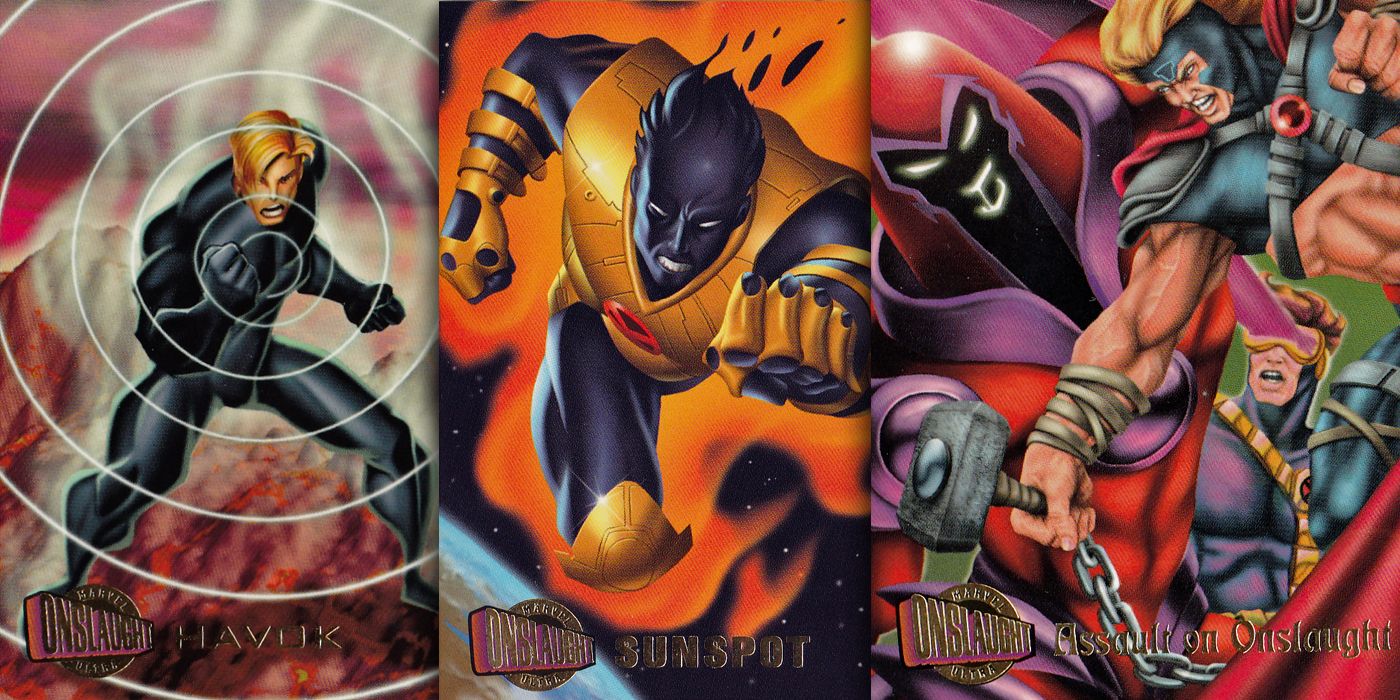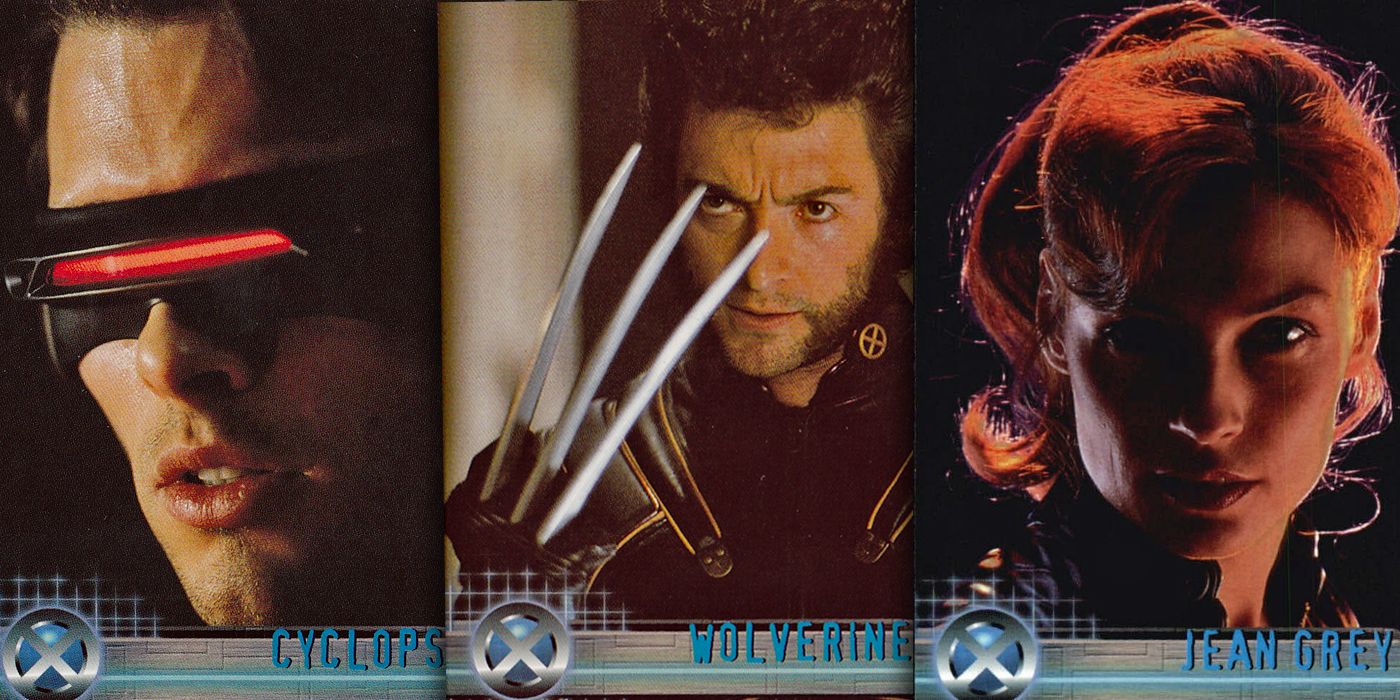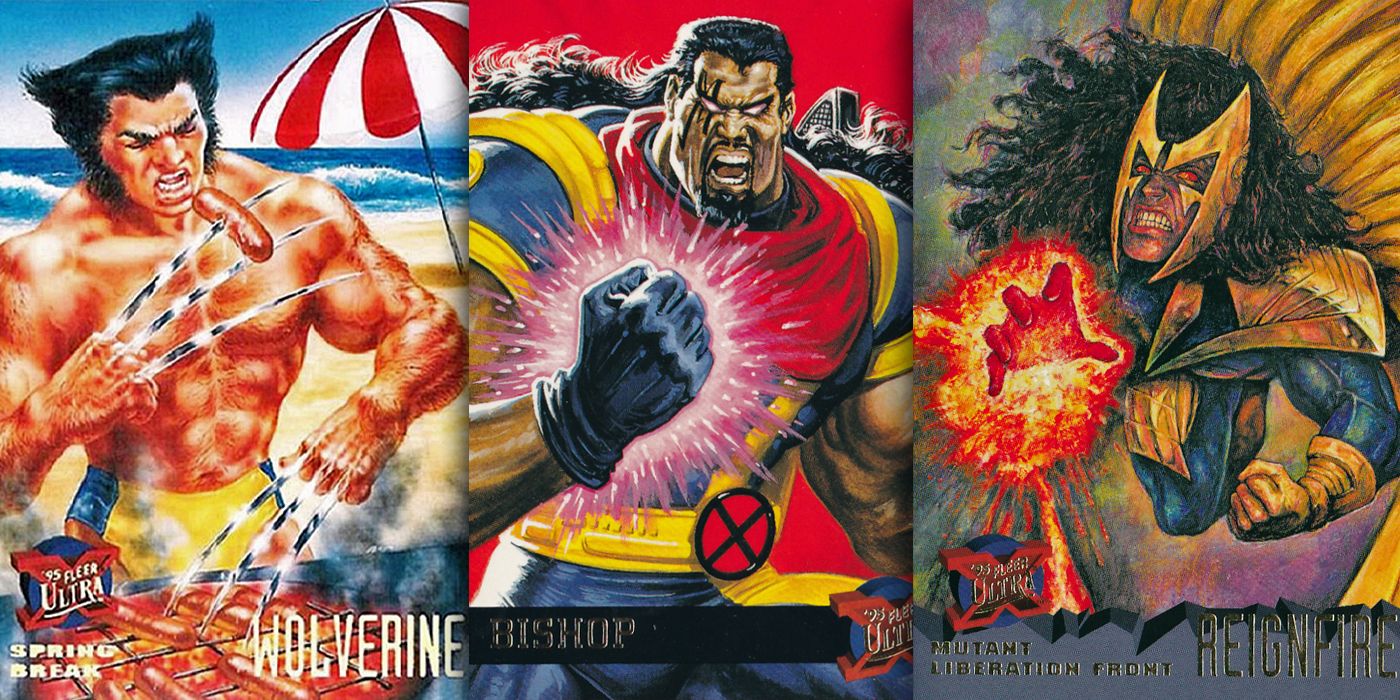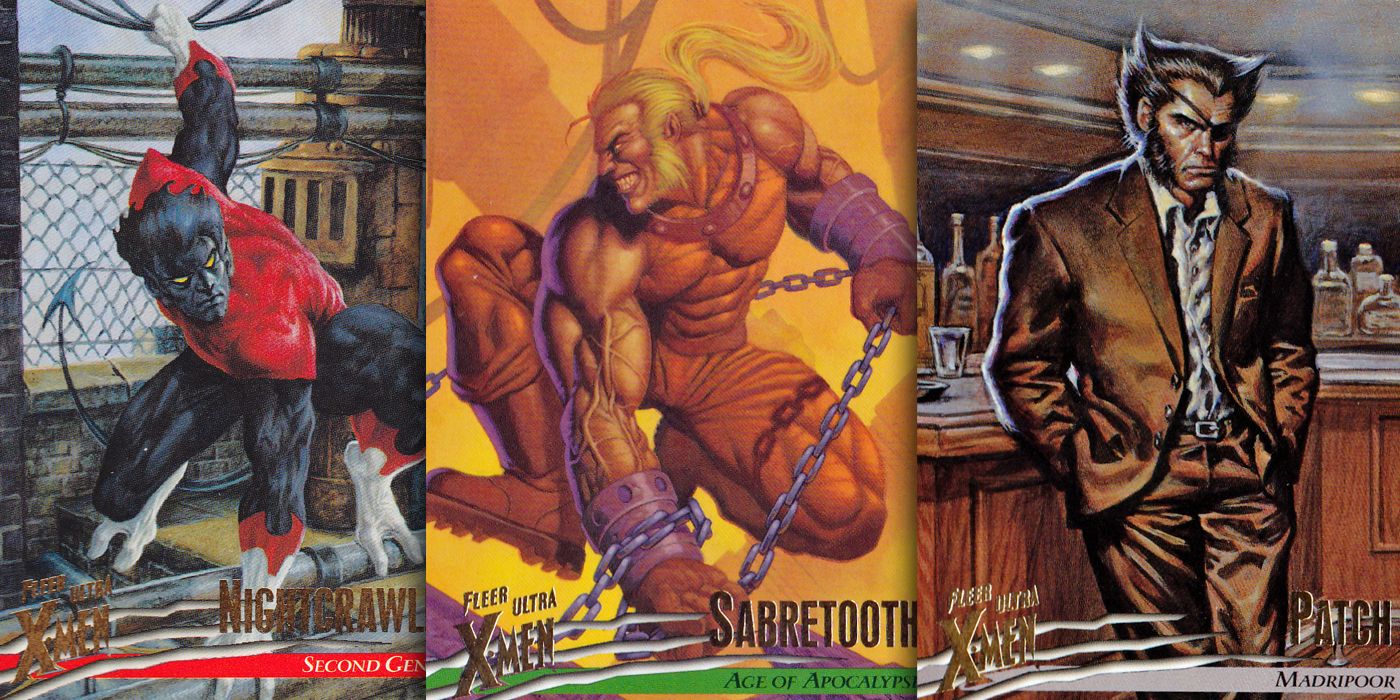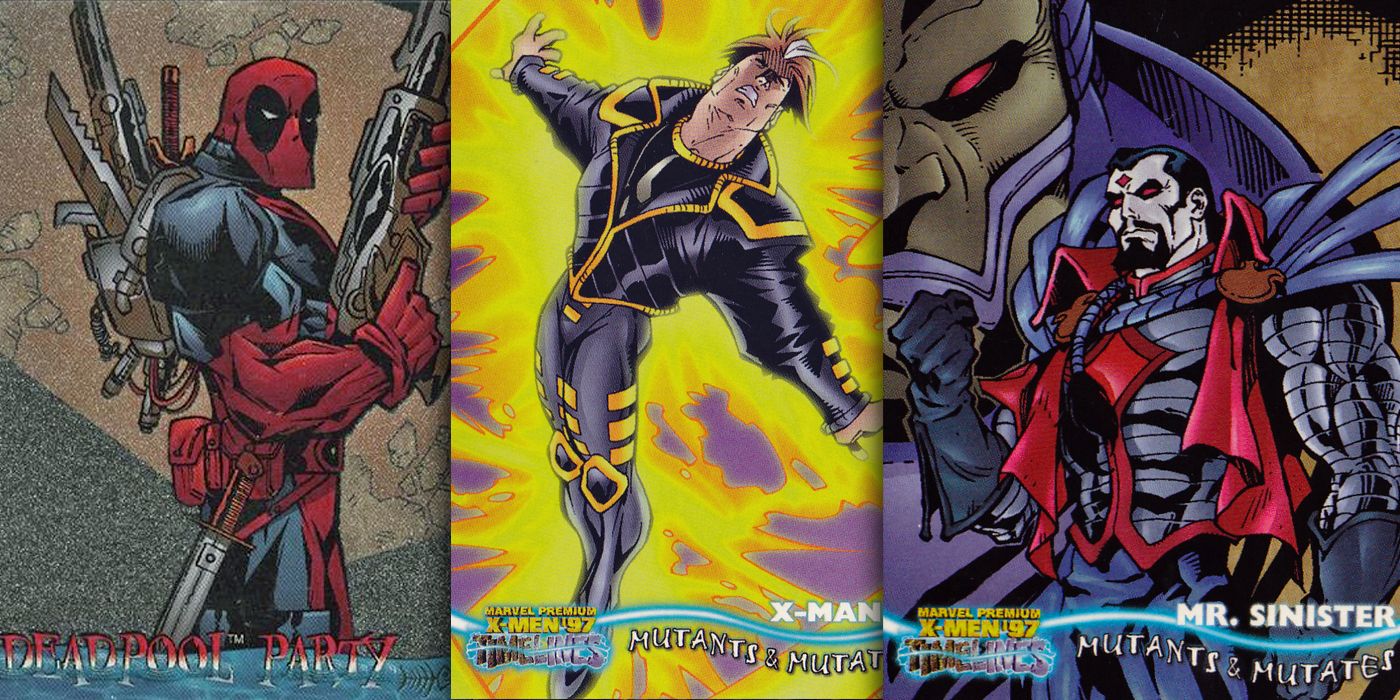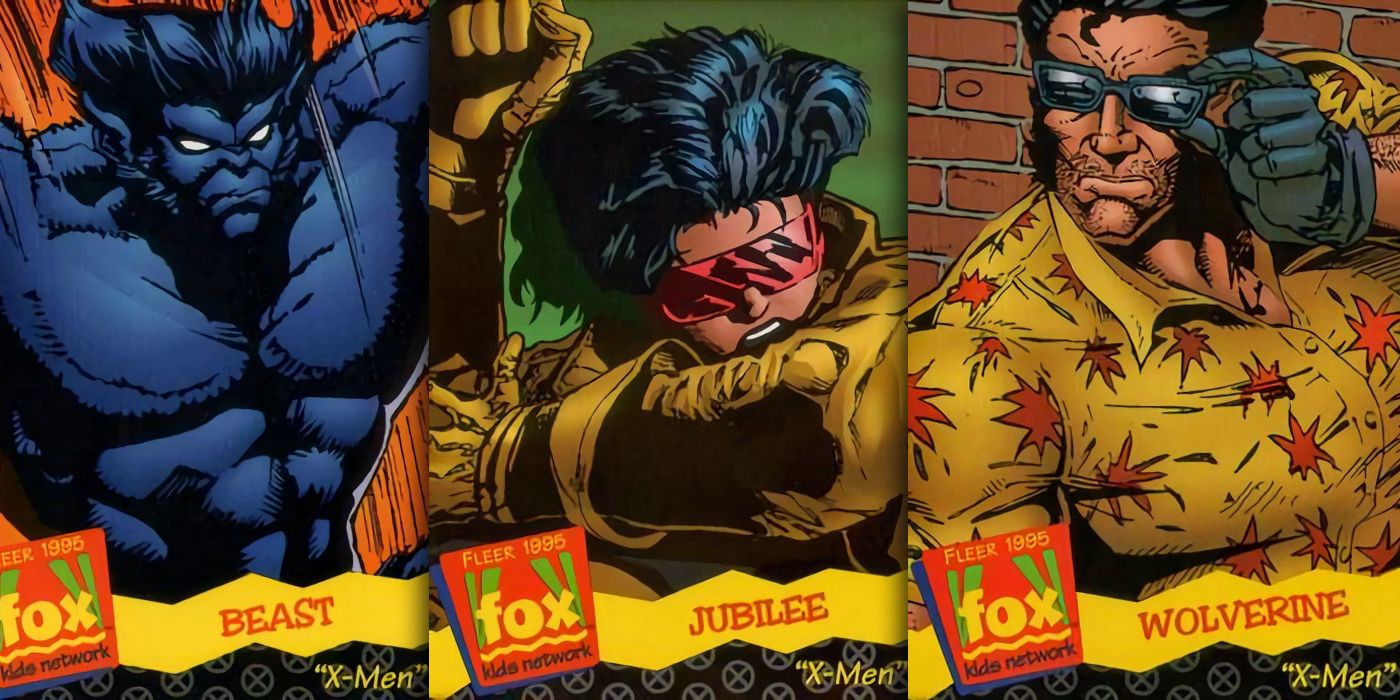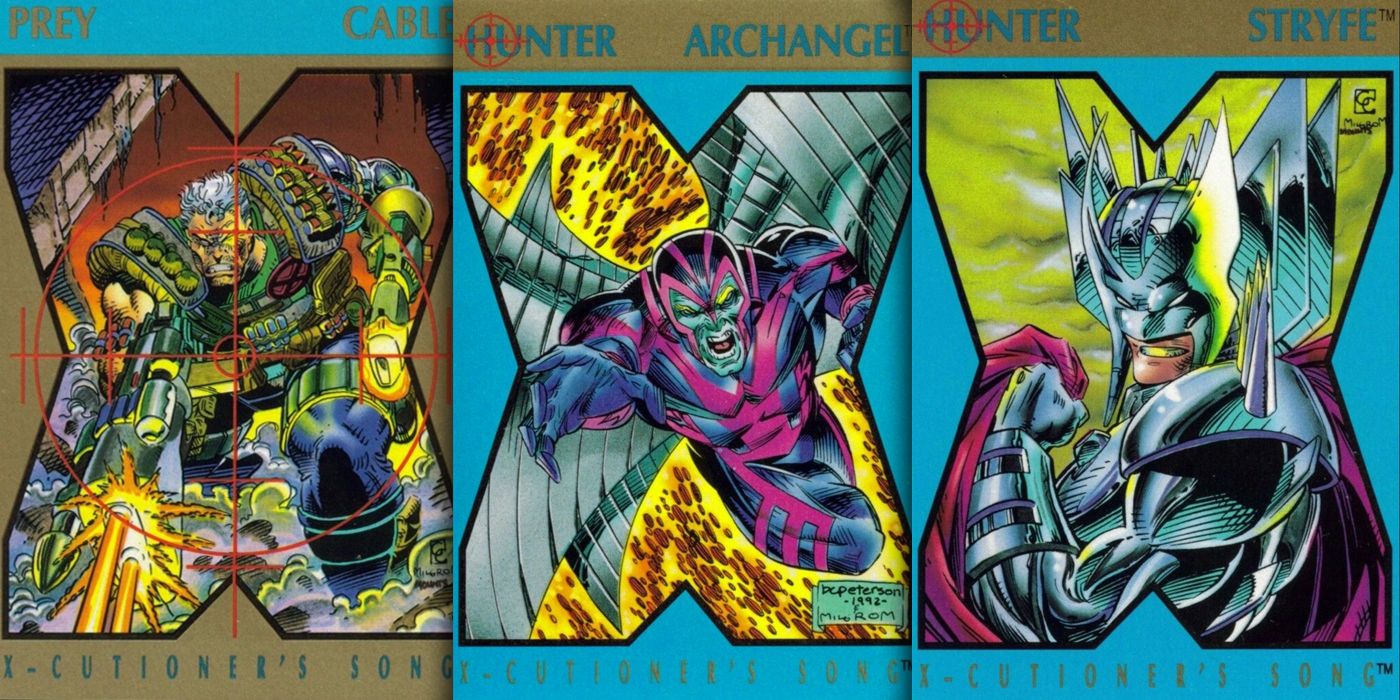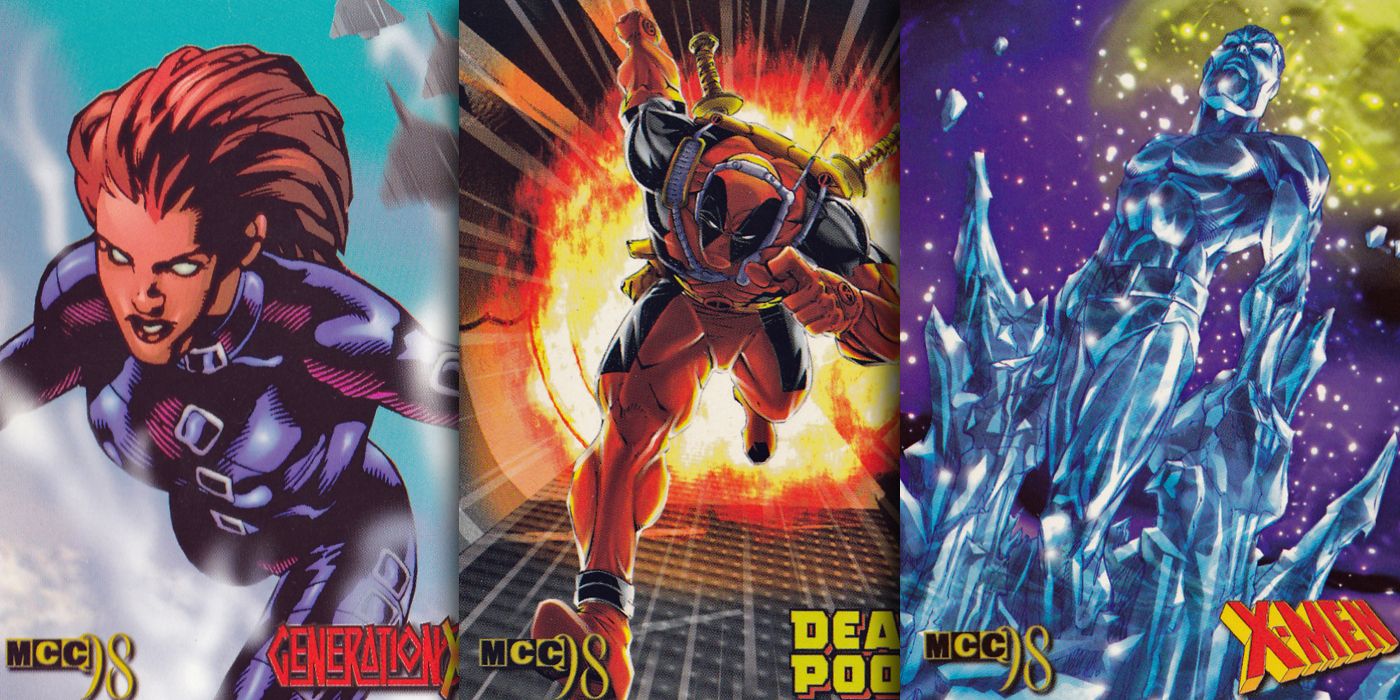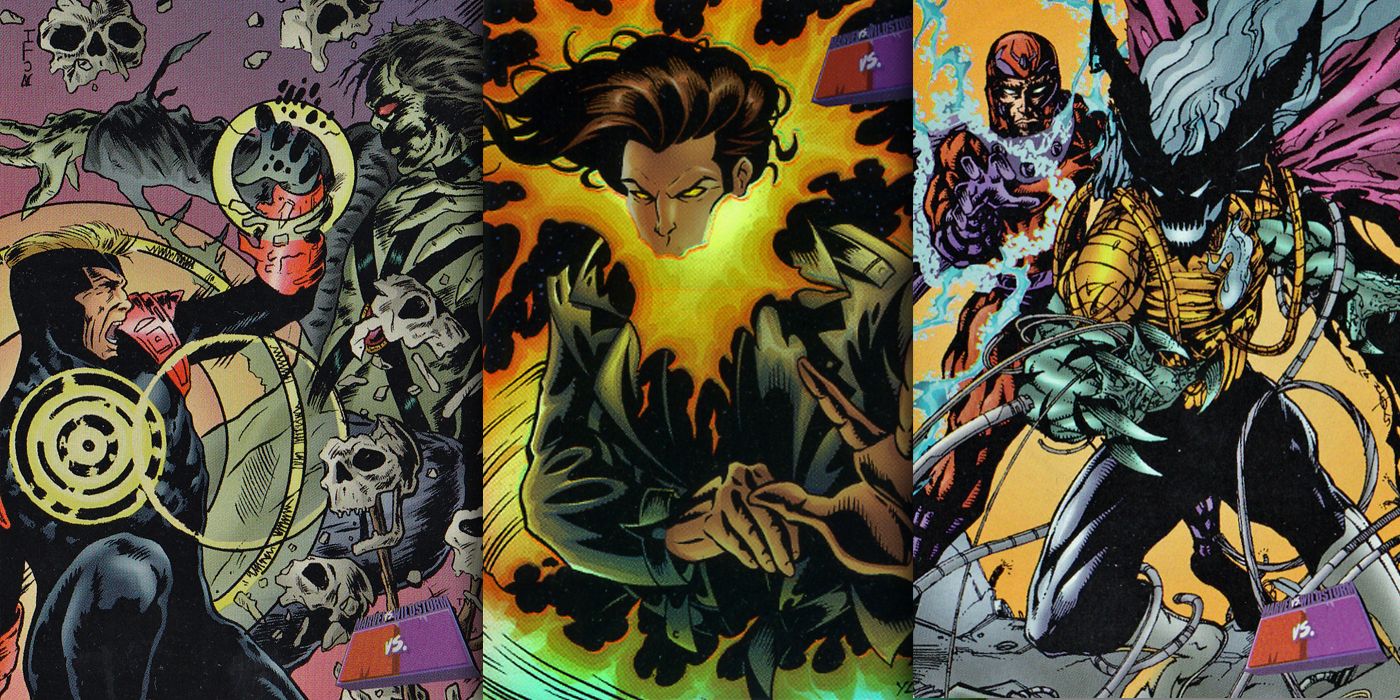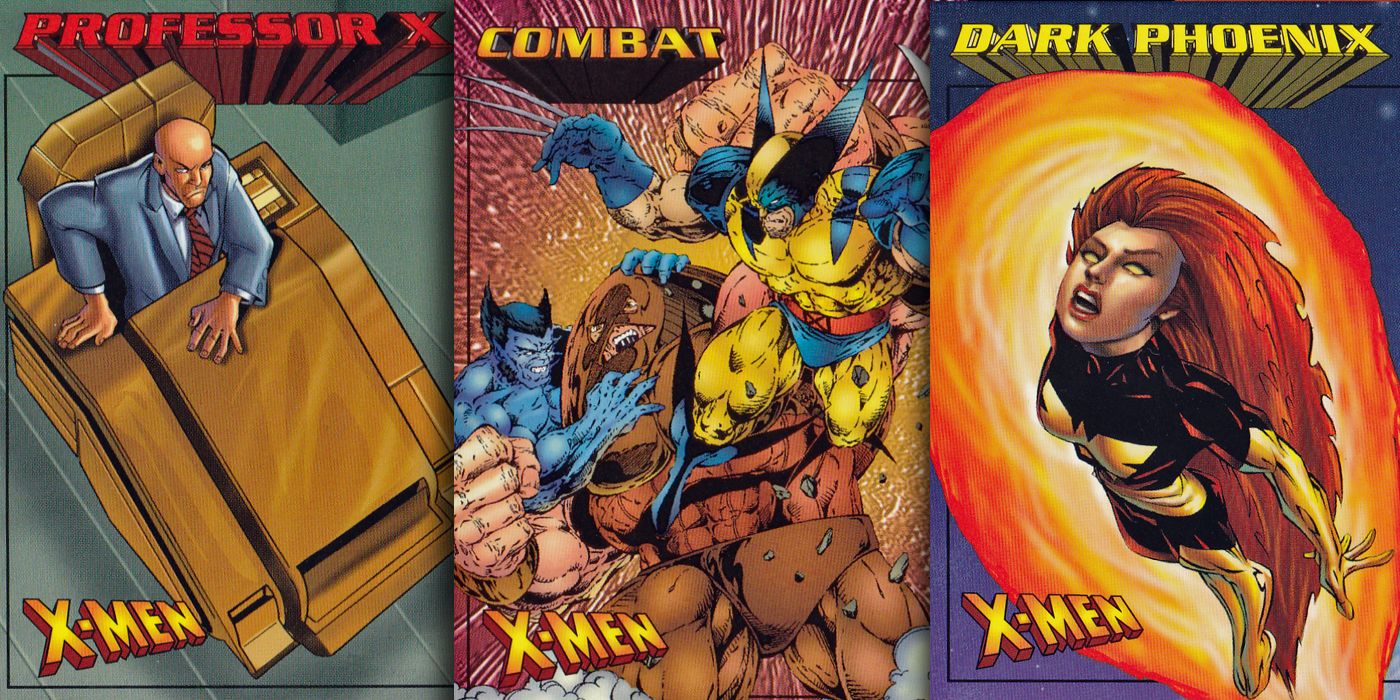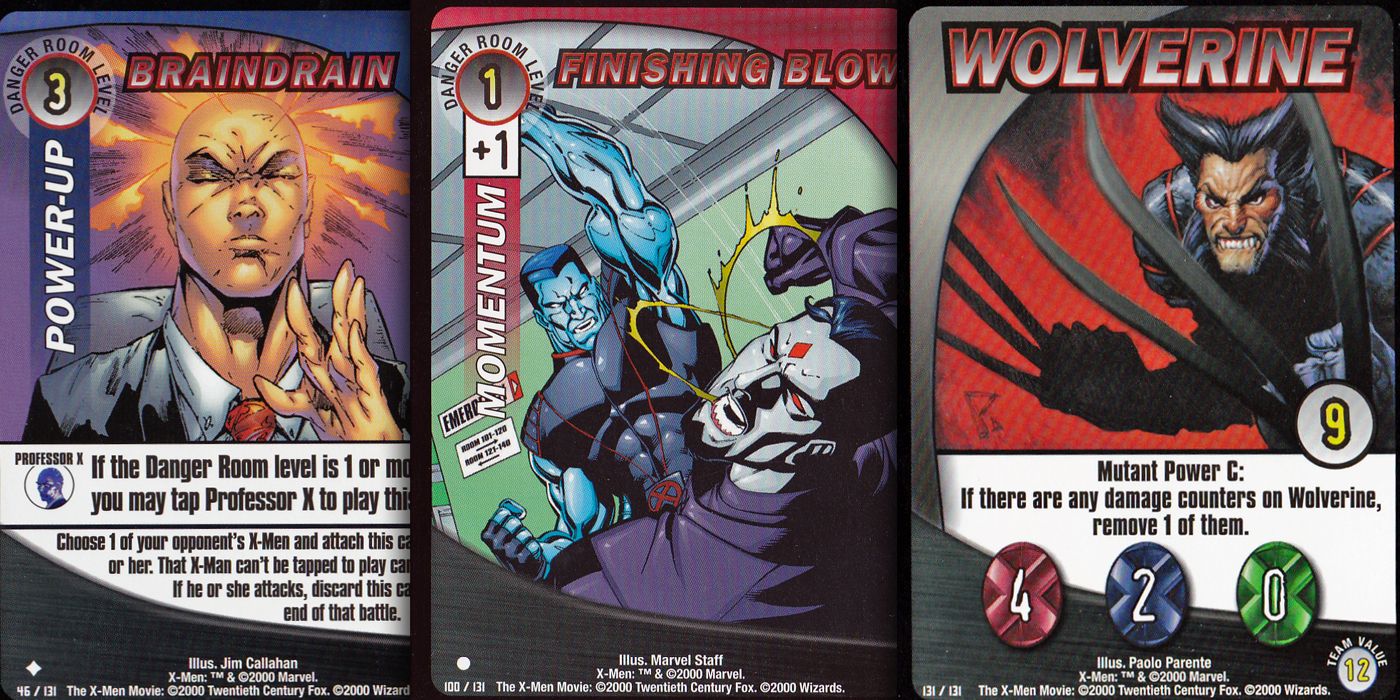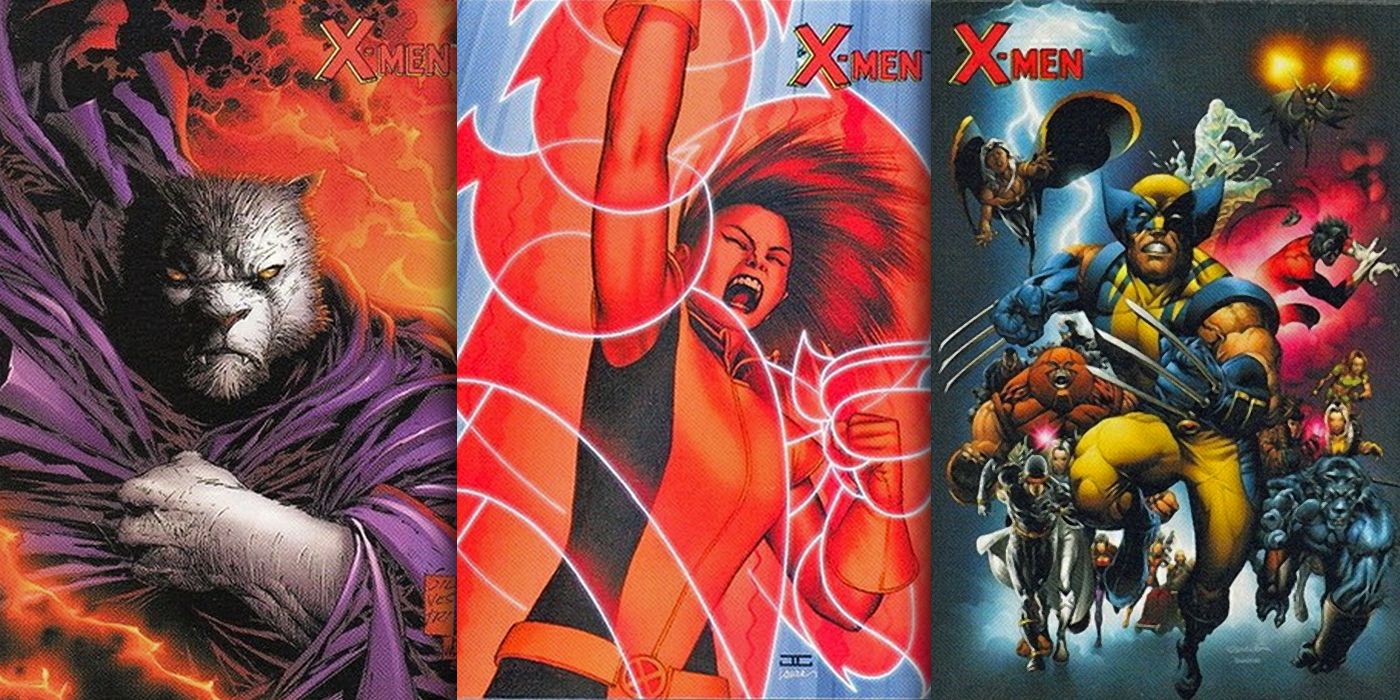During the X-Men's most popular era, trading cards were a massive part of the collecting world. In the late 1980s and 1990s, everything from Super Mario Brothers: The Movie to Bill Nye The Science Guy had a trading card set of its own. While superhero cards had been around for a while by then, Marvel perfected the comic book card formula with a 1990 series that combined baseball card-like statistics with dynamic new artwork. In a time before reprints and Wikipedia summaries put facts at fans' fingertips, these trading cards were the best way for fans to get the rundown on their favorite characters.
Since they were Marvel's biggest heroes at the time, the X-Men played a big role in the ensuing onslaught of superhero cards. Even though they made totally forgettable characters like Adam X the X-Treme seem just as important as Professor X, these cards were a way for X-fans to relive classic moments and learn obscure details about Marvel's mightiest mutants. Now, CBR is taking a look back at some of the trading cards every X-Men fan owned. In this list, we'll be going through some of the biggest, weirdest and rarest X-Men card sets ever released.
20 JIM LEE'S X-MEN SERIES 1
Thanks to almost 100 pieces of all-new artwork from superstar artist Jim Lee, the X-Men got their first iconic set of trading cards in 1992. Even though they weren't the first X-Men cards, this super-popular set was the first X-Men set to feature original artwork, power rankings and "X-tra" fun facts. The card company Impel, which evolved into card giant SkyBox, produced the set, which featured 100 basic cards and a few special "hologram" cards with 3D effects.
Like most of the era's X-Men cards, this series mixed major X-Men like Cyclops and Storm with the stars of then-current storylines. New characters like Maverick and Omega Red had cards, even though they had just been introduced in Jim Lee's then-ongoing run on X-Men. Although Lee hasn't worked for Marvel in 20 years, Marvel used his iconic X-Men card drawings for a series of variant comic covers in 2017.
19 X-MEN FLEER ULTRA '94
Near the height of the trading card collecting boom, Marvel purchased the trading card company Fleer. Although this decision eventually came back to haunt Marvel, it also produced some jaw-dropping X-Men cards. While earlier X-Men cards featured comic book-style art, the X-Men Fleer Ultra '94 series centered around fully painted artwork. With a massive 150 base cards, this set featured a diverse array of characters and teams along with lushly-rendered moments from the X-Men's most famous battles.
While most of the cards had biographical information about characters, a special holographic set highlighted the then-recent crossover "X-Men: Fatal Attractions," where Magneto pulled out Wolverine's adamantium skeleton. To advertise the set, some of these cards were packed in with Marvel's X-Men comics and Toy Biz's X-Men action figures. In late 1994, Marvel released X-Men: The Ultra Collection, which reprinted the art for every card in a comic book format.
18 PIZZA HUT CARDS
By 1993, the X-Men had jumped from comics to take over Saturday morning cartoons with the beloved X-Men: The Animated Series. To cash in on the mutants' massive multimedia success, Pizza Hut started a nationwide promotion featuring the X-Men. For the low price of $4.99, about $8.50 today, Pizza Hut diners could purchase one of two versions of the X-Men Creators' Choice pack.
Both versions of the pack contained a VHS videotape with two episodes of X-Men: The Animated Series and a roundtable interview with Stan Lee and some other X-Men comic creators. Each of the packs also contained a comic book and a trading card that weren't available anywhere else. Since the packs were sealed, the cards doubled as the box art for the videotapes and were hopelessly lost as soon as they were unwrapped.
17 OVERPOWER
After Magic: The Gathering invented the collectible trading card game and became a sensation, Fleer released Marvel's first trading card game OverPower in 1995. In the game, two players would battle each other with teams of four heroes. The rest of their decks featured cards that could modify their offensive or defensive abilities or set special rules for a match. Before the cards were discontinued in 1999, there were well over 2,000 OverPower cards, counting reissues, that featured characters from Marvel, DC and Image Comics.
The X-Men were largely the public face of OverPower throughout its lifespan. About half of the game's original set of cards were X-Men characters, and they were prominently featured in the game's massive advertising campaign. OverPower's later expansions highlighted X-Men characters and even incorporated elements from X-storylines like "Age of Apocalypse," "Onslaught" and the alternate reality series Mutant X.
16 X-MEN SKYBOX SERIES 2
By the time trading card maker Impel changed its name to SkyBox, Jim Lee had left Marvel to co-found Image Comics. So for SkyBox's X-Men Series 2, the company recruited an array of top Marvel artists who were already drawing X-Men titles. With work from artists like Andy Kubert, Greg Capullo, Alan Davis and future Marvel chief Joe Quesada, this 100-card base set focused on heroes and villains from the world of the X-Men and other mutant teams like X-Force.
Like most of the era's X-Men trading cards, these cards were packed in with Toy Biz's X-Men action figures. Instead of featuring straightforward biographical information, the descriptions on the backs of these cards were written from the perspective of Charles Xavier. Professor X. Outside of a few special holographic cards, almost all of these cards were written as entries "Xavier's Files."
15 X-FORCE #1 CARDS
In 1991, Rob Liefeld and Fabian Nicieza's X-Force #1 shattered records by selling an estimated 4 million copies. While there was a lot of excitement about the first adventure of Cable's new militaristic mutant team, trading cards were a big part of the comic's success. To appeal to the collectors' markets for both comics and cards, Impel produced a small set of five X-Force cards that was only distributed with copies of X-Force #1.
Each copy of X-Force was polybagged with a card that had Cable, Shatterstar, Deadpool, the duo of Sunspot and Gideon or the whole X-Force team on it. While most superhero trading cards aren't worth much today, bagged copies of X-Force #1 with a Deadpool card inside are worth a few dollars more than the other versions of the issue.
14 FLEER X-MEN '96
After a few sets of fully painted cards, Fleer's X-Men cards took a decidedly different approach in 1996 by embracing computer-based coloring techniques. With art from the comic book art dynasty of Joe, Adam and Andy Kubert, this 100-card set boasted "CGI"-colored artwork that covered a variety of major and minor X-characters. In addition to basic biographical information, the character cards also featured updates on then-recent comic book storylines and, where applicable, X-Men: The Animated Series.
In a bizarre twist, this series also featured a subset of "Haunted Mansion" cards, which featured the X-Men dressed up in Halloween costumes. While Colossus and Rogue both cosplayed as vampires, Cyclops wore an Elvis costume. Still, the strangest card in the set was Beast, who was about to fly a kite in a lightning storm while dressed as an inexplicably spooky Ben Franklin.
13 MARVEL VISION
Between 1994 and 1996, there were four ongoing cartoons based on Marvel characters. While the X-Men, Spider-Man, Iron Man and Fantastic Four cartoons had varying levels of success, they all came together in the Marvel Vision trading card series. Released by the newly-merged Fleer/SkyBox, this 100-card series leaned heavily on the hyper-popular X-Men.
While the set stuck exclusively to major characters who appeared on TV, the Marvel Vision cards still had a few novel quirks. The entire series was embossed, so every card had a raised texture and a slight 3D effect. Along with some very brief biographical info, each card also had a trivia question with a scrambled answer on its backside. The answers could only be decoded with particularly sharp eyesight or the "Marvel Vision Encryptalyzer," a thin piece of red plastic. Each booster pack also contained a "mini-magazine" and a temporary tattoo.
12 ONSLAUGHT
Since collected editions of classic and recent stories weren't widely available in the 1990s, trading cards were one of the best ways to stay up-to-date with the Marvel Universe. In 1996, that was especially true with Fleer's Marvel Ultra Onslaught series. That 100-card series was built around the massive X-Men-centric crossover "Onslaught," where Professor X's dark side became a psychic entity that threatened the Marvel Universe.
In a dark twist on the cards that were written in Professor X's voice, most of these cards were written from the perspective of Onslaught. In addition to character cards for the story's major players, the set featured story cards that essentially summarized the entire crossover. Outside of the X-Men, the series also featured several cards that previewed the Heroes Reborn imprint, which followed the Avengers and Fantastic Four after they were shunted off into an alternate universe during "Onslaught."
11 X-MEN MOVIE CARDS
Even more than superhero cards, movie-based trading card sets thrived for decades. Although the film and superhero trading card markets had already peaked by then, Topps still released a set for X-Men when that movie was released in 2000. That 72-card set featured character cards for the film's main cast, behind-the-scenes cards and story cards that summarized every scene in the movie.
In 2002, Topps released a similar set for X2: X-Men United, and Rittenhouse released sets for 2006's X-Men: The Last Stand and 2009's X-Men Origins: Wolverine. All of these sets featured special cards with swatches of fabric from costumes that were used on screen. They also featured even rarer autograph cards that were signed by the films' casts. With values in the triple digits, autograph cards for actors like Hugh Jackman, Ian McKellen and Patrick Stewart are easily the most valuable X-Men trading cards ever released.
10 X-MEN '95 FLEER ULTRA
While the painted artwork on some of early X-Men trading cards could be mistaken for highly-stylized abstract art, the X-Men's trading cards took a more realistic turn in the mid-1990s. In 1995, Fleer's Ultra X-Men set dazzled fans with a fully-painted set of cards with striking, hyper-detailed art. In addition to 150 base cards, the series also included foil-stamped inserts and transparent cards for X-Men: The Animated Series.
Beyond the primary and secondary X-Men, this set also featured cards for largely forgotten X-characters like Reignfire, Prior Turrin and Mondo. Along with cards commemorating famous battles, the set also included a somewhat infamous "Spring Break" subset. These nine cards showed the swimsuit-clad X-Men enjoying a day at the beach. This mind-boggling set included Iceman melting in the sun, Jubilee rubbing sunscreen on Professor X's head and Wolverine eating an especially plump hot dog.
9 FLEER ULTRA X-MEN: WOLVERINE '96
To distinguish it from the three other sets of X-Men cards Fleer released in 1996, Fleer's Ultra X-Men: Wolverine set had a few memorable quirks. As its name suggests, the 100-card set was focused on Marvel's most bankable mutant, Wolverine. In addition to 30 cards featuring Wolverine in some form, the fully-painted set featured a variety of battles, allies and enemies from every era of Wolverine's life, including the just-finished "Age of Apocalypse" crossover.
The backs of Fleer's Wolverine card set were also unique, since they only had a minimal amount of information about the front of the card. Each card featured another panel to an original X-Men story. While this in-continuity story has never been reprinted, it saw the X-Men battle the media-obsessed villain Mojo II, who technically debuted in Jim Lee's X-Men trading cards before he appeared in a comic book.
8 X-MEN: TIMELINES
By 1997, the collapse of the collectible trading card market had played a big role in Marvel's bankruptcy. Despite that, Fleer/SkyBox still produced another solid set of trading cards with Marvel Premium X-Men '97: Timelines. While Marvel faced an uncertain future, this set of cards drew on the X-Men's history with card-backs that summarized a wide array of X-Men stories. Most of these stories involved the X-Men villains Mister Sinister and Apocalypse or the dark alternate timelines they helped shape.
In addition to the 81-card base set, this set also shined a light on the X-Men's then-new recruits like Marrow and Maggot. The series also included a set of "Deadpool Party" cards, the first subset of trading cards dedicated to Marvel's Merc With A Mouth. Those cards focused on Deadpool, Blind Al and a few other characters who were part of the Joe Kelly-penned Deadpool comic.
7 FLEER FOX KIDS
In one of the stranger decisions from the 1990s, Fleer released a set of cards based on cartoons that aired on the Fox Kids programming block in 1995. This 150-card set featured a bizarre selection of characters and scenes from tonally disparate cartoons. Cards from the X-Men and Spider-Man cartoons were released alongside cards from forgotten kids cartoons like Bobby's World and Eek! The Cat. In an attempt to bridge those two worlds, most of the cards in the set featured the well-remembered superhero parody The Tick.
The X-Men cards exclusively dealt with characters that had roles on X-Men: The Animated Series, plus a version of Wolverine conspicuously undercover in a Hawaiian shirt. The X-Men were also featured in "Power Pop-Ups," which were essentially trading card-size retractable cardstock cut-outs that were packed in with the cards.
6 X-CUTIONER'S SONG
After trading cards helped make X-Force #1 a sales smash in 1991, Marvel tried a similar tactic with the 1992 crossover "X-Cutioner's Song." Across 12 issues of Uncanny X-Men, X-Men, X-Factor and X-Force, the crossover chronicled the X-Men's final battle against the time-traveling villain Stryfe and teased Cable's true origin. To help boost sales, each issue of the crossover was poly-bagged with a different SkyBox-produced X-Cutioner's Song trading card.
Each of these 12 comic-exclusive cards was written as an entry in "Stryfe's Strike File." In keeping with Stryfe's zero-sum perspective, the characters, duos and teams on the cards were all described as either "Hunter" or "Prey." Stryfe's bombastic, overwrought descriptions were especially entertaining. For instance, he compared the X-Men's Archangel to "a shiny silver quarter" that "catches the Devil's light just so."
5 MARVEL CREATORS COLLECTION
While 1990s' superhero cards were built around new art and details about the characters and events they depicted, the Marvel Creators Collection took a different approach. Instead of original art, this 1998 SkyBox series mainly featured pre-existing art from comics that was recolored or given a digitally-created background.
Instead of biographical information about characters, the 73-card base set featured comments from writers, artists and editors who were working on those characters' monthly comic books. On one of the set's many X-Men cards, former Uncanny X-Men writer Steven Segale wrote about an unused X-Men storyline that would've seen the X-Men trapped in a prison camp. Since they had ongoing comics at the time, the X-Men allies Generation X, Ka-Zar and Alpha Flight were well-represented in the set. The set's inserts included comic creator autograph cards and sketch cards drawn by Mike Wieringo.
4 MARVEL VS. WILDSTORM
During the 1990s, the heroes and villains from different comic book publishers teamed up to duke it out in some of the decade's most hotly-anticipated stories. Starting in 1996, characters from Marvel and WildStorm Productions, Jim Lee's Image Comics imprint, encountered each other in several small comic crossovers. In 1997, Fleer/SkyBox brought those stories together and added some new showdowns with its X-Men-heavy Marvel vs. WildStorm trading card set.
In addition to characters and scenes from the comic crossovers, this 90-card set featured several original showdowns that couldn't be seen anywhere else. These battles pit some of Marvel's most iconic heroes against some of WildStorm's vaguely recognizable characters. This card set marks one of the last crossovers between the two publishers before DC Comics bought WildStorm in 1998.
3 X-MEN SKYBOX 1997
Between the collapse of the trading card market and Marvel's ongoing bankruptcy proceedings, the fact that any X-Men cards were released in 1997 is remarkable. Still, Fleer/SkyBox's 1997 set of X-Men cards showed the ravages of those events. Where Fleer once released 150- cards sets with cards that dug deep into the X-Men roster, this 50-card set only featured characters that had appeared in X-Men: The Animated Series.
Even though this series marked the return of ranked character power levels, the overall production quality of the cards left a lot to be desired. Instead of fully-painted cards with a glossy finish, this plastic-y set of cards mostly featured simplified, cartoony images of various X-Men characters and teams. On the plus side, booster packs of these cards usually cost less than $1 and included three OverPower game cards.
2 X-MEN: THE TRADING CARD GAME
A few years after bringing the Pokémon Trading Card Game to the United States, Wizards of the Coast tried to revive the concept of the superhero collectible card game with X-Men: The Trading Card Game. With input from Wizards of the Coast, Marvel and Twentieth Century Fox, the game was released in 2000 as a tie-in to the X-Men's first movie. In the game, two players competed to see who could they could knock out with a combination of character cards, power-up cards, mission cards and dice rolls.
After the first set of 131 cards wasn't terribly successful, plans for an expansion set were scrubbed. However, the game still offered a unique spin on some classic X-Men characters. Even though they weren't in the first X-Men movie, characters like Colossus, Psylocke and Mister Sinister were redesigned in the film's sleek all-black style for their inclusion in the game.
1 X-MEN ARCHIVES 2009
Even though superhero trading cards aren't anywhere as popular as they were in the 1990s, Marvel trading cards are still released on a fairly regular basis. While those more recent sets usually focus on the Avengers and the Marvel Cinematic Universe, the most recent set of X-Men cards was released in 2009. Produced by Rittenhouse Archives, the X-Men Archives consisted of a 72-card base set with a few dozen special insert cards.
These cards relied heavily on pre-existing art and usually featured fairly recent comic book covers with the text removed. Although a few of the special cards had biographical information on the back, most of the cards in this series only had an artist credit and design work on their backside. While the X-Men have still popped up some in other recent Marvel sets, the X-Men Archives marked a quiet end to the X-Men's once-mighty trading card empire.

